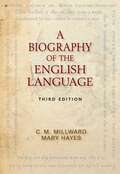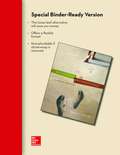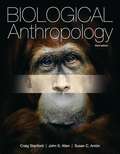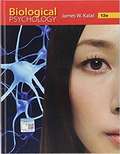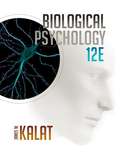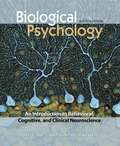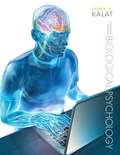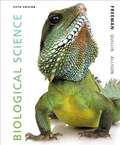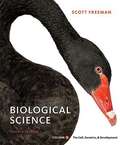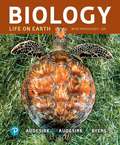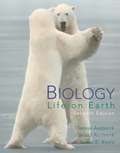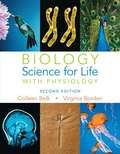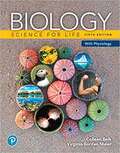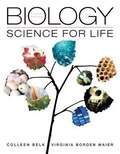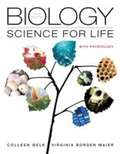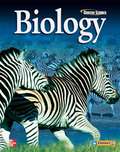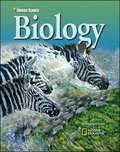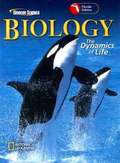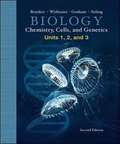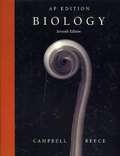- Table View
- List View
A Biography of the English Language
by C. M. Millward Mary HayesThe third edition of A BIOGRAPHY OF THE ENGLISH LANGUAGE continues to examine the structure of English, from its Indo-European pre-history, through the invasions that shaped Old and Middle English, through its speakers' conscious efforts to police it in the Early Modern period, through its present-day transformations manifest in urban slang and text-messaging. <p><p>The textbook explores three important issues: how languages and language change are systematic; how the inner history of a language is profoundly affected by its outer history of political and cultural events; and how the English of the past has everywhere left its traces on present-day English. By uncovering the language's past, one can better use it to communicate as well as speculate about its future use in ever-changing globalized media.
Biological Anthropology: Concepts and Connections
by Agustín FuentesBiological Anthropology: Concepts and Connections shows the relevance of anthropological concepts to today's students and encourages critical thinking. Throughout the text and especially in its many “Connections” features, Agustin Fuentes links anthropological concepts and questions to students’ lives. One of the top scholars in the field of biological anthropology, Agustin Fuentes’ current research looks at the big questions of why humans do what they do and feel the way they feel. He is committed to an integrated, holistic anthropological approach. Fuentes wrote this text to help answer the “so what” questions and make anthropological knowledge relevant to everyday life.
Biological Anthropology (3rd Edition)
by Craig Stanford John S. Allen Susan C. AntonDiscover the Best of Biological Anthropology: From its Earliest Foundations to its Most Current Innovations Biological Anthropology, 3/e is written to appeal to a wide range of students. It continues to build upon the strength and success of its first and second editions by integrating the foundations of the field with the most current innovations happening today. Over the past 40 years, biological anthropology has rapidly evolved from the study of physical anthropology into biological anthropology. Biological anthropology is now an integrative combination of information from the fossil record and the human skeleton, genetics of individuals and of populations, our primate relatives, human adaptation, and human behavior. The third edition of Biological Anthropology combines the most up-to-date, comprehensive coverage of the foundations of the field with modern innovations and discoveries. Teaching and Learning Experience Personalize Learning - MyAnthroLab delivers proven results in helping students succeed, provides engaging experiences that personalize learning, and comes from a trusted partner with educational expertise and a deep commitment to helping students and instructors achieve their goals. Improve Critical Thinking - Visual summaries, critical thinking questions, Insights and Advances boxes and author suggested readings found within each chapter encourage students to examine assumptions, discern hidden values, evaluate evidence, assess conclusions, and more!
Biological Evidence
by Ann Bucholtz Jon Lewis"The text is an introduction to the types of biological evidence commonly found at crime scenes and how to collect it for non-science majors and for professionals working in the criminal justice system. Specific biological evidence discussed includes blood, semen, saliva, urine, feces, hair, and fingernails. Additional topics include autopsy, the basic departments of the crime laboratory, toxicology, forensic entomology, and uncollectible biological evidence. Packaging, preservation, and care of biological evidence is discussed and chain of custody is explained. Additional topics include DNA, case studies, courtroom testimony, and exhibits for the courtroom.
Biological Psychology (Mindtap)
by James KalatThe most widely used text in its course area, James W. Kalat's BIOLOGICAL PSYCHOLOGY has appealed to thousands of students before you. Why? Kalat's main goal is to make Biological Psychology understandable to Psychology students, not just to Biology majors and pre meds--and he delivers. Another goal is to convey the excitement of the search for biological explanations of behavior. Kalat believes that Biological Psychology is "the most interesting topic in the world," and this text convinces many students--and maybe you, too--with clear writing, amusing anecdotes and intriguing examples. MindTap, an interactive online learning resource that integrates the text with videos, animations and a virtual bio-lab component, makes learning even easier and more enjoyable.
Biological Psychology
by James W. KalatDr. James W. Kalat's BIOLOGICAL PSYCHOLOGY is widely used for good reason: an extremely high level of scholarship, a clear writing style with amusing anecdotes, and precise examples. Kalat's goals are to make biological psychology accessible and to convey the excitement of the search for biological explanations of behavior, and he delivers. Updated with new topics, examples, and recent research findings, the new 12th edition continues this book's tradition of quality.
Biological Psychology: An Introduction to Behavioral and Cognitive Neuroscience
by Mark R. Rosenzweig S. Marc Breedlove Neil V. WatsonBiological Psychology is a comprehensive survey of the biological bases of behavior that is authoritative and up-to-date. Designed for undergraduates enrolled in Biological Psychology, Physiological Psychology, or Behavioral Neuroscience, the book continues to offer an outstanding illustration program that engages students, making even complicated topics and processes clear. It offers a broad perspective, encompassing lucid descriptions of behavior, evolutionary history, development, proximate mechanisms, and applications. The Sixth Edition features a thoroughly redesigned and up-to-date Cognitive Neuroscience module (Part VI; Chapters 17-19), with expanded coverage of attention, executive control, and decision-making processes, in keeping with the latest research breakthroughs. Optional advanced topics are available on the Web as "A Step Further," streamlining the printed text to emphasize the important points. The new edition boasts hundreds of new references, including research students may have encountered in the popular media. Yet critical thinking skills are also honed as the reader is alerted to the many widely held myths about the neuroscience of behavior and educated about facts that sound unlikely to the uninformed. Thorough and reader-friendly, Biological Psychology reveals the fascinating interactions of brain and behavior. KEY FEATURES * The book has an outstanding full-color art program, including hundreds of original illustrations that make it easy to understand structures, mechanisms, and processes in the brain. * Each chapter opens with a brief outline and a narrative illustrating an important aspect of behavioral biology that will be made clear to the student by reading the rest of the chapter. * Redesigned chapter summaries are organized by main chapter heads in a readable two-column format. Each has bold-faced key terms, callouts to pertinent figures, and references to the Companion Website.
Biological Psychology (Eleventh Edition)
by James W. KalatThe most widely used text in its course area, Dr. James W. Kalat's BIOLOGICAL PSYCHOLOGY appeals to students and instructors alike. Throughout all eleven editions, the goal has been to make biological psychology accessible to psychology students, not just to biology majors and pre-meds. The goal has also been to convey the excitement of the search for biological explanations of behavior. Kalat believes that biological psychology is "the most interesting topic in the world," and this text convinces many students--and perhaps you, too--with its clear writing style, amusing anecdotes, and intriguing examples. A media-rich, highly interactive online eBook integrates the text with videos, animations, and an online bio-lab component, making it easier for you to learn.
Biological Science
by Scott Freeman Lizabeth Allison Michael Black Greg Podgorski Kim Quillin Jon Monroe Emily TaylorBiological Science, Fifth Edition contains many new or expanded features, all of them targeted at ways to help students learn to construct their own knowledge and think like biologists. The book provides scaffolding to help students learn at the level called for by the National Academy of Sciences, the Howard Hughes Medical Institute, the American Association of Medical Academies, and the National Science Foundation.
Biological Science, Volume 1: The Cell, Genetics, and Development (4th Edition)
by Scott FreemanBuilding upon Scott Freeman's unique narrative style that incorporates the Socratic approach and draws you into thinking like a biologist, the Fourth Edition has been carefully refined to motivate and support a broader range of learners as they are introduced to new concepts and encouraged to develop and practice new skills. Each page of the book is designed in the spirit of active learning and instructional reinforcement, equipping novice learners with tools that help them advance in the course-from recognizing essential information in highlighted sections to demonstrating and applying their understanding of concepts in practice exercises that gradually build in difficulty.
Biological Sciences in the Laboratory
by Ronald MollickWelcome to the Biology laboratory! This laboratory course is designed to meet one of the requirements of the Liberal Learning Core Curriculum. One of the Liberal Learning Areas of Inquiry is "Investigating the Natural World." This Area of Inquiry requires students to successfully complete two lecture classes and one laboratory class. The laboratory class must be related to one of the lecture classes taken. To use Biology 109L to help complete this requirement you must be currently enrolled in or have already completed one of the following: Biology 107, 108, 111, 112, 113, 114 or 115.
Biology: Life On Earth With Physiology
by Gerald Audesirk Teresa Audesirk Bruce E. ByersThe 12th Edition offers the most comprehensive coverage at the most affordable price for the non-majors biology student. This loose-leaf edition maintains its conversational, question-and-answer presentation style that has made it a best-seller. The new edition expands its focus on the process of science with new Doing Science boxes throughout the text that walk students through the scientific process, and interactive Doing Science coaching activities in Mastering Biology. The text also provides Think Deeper questions that give instructors guidance for starting classroom discussions that promote critical thinking.
Biology: Life on Earth (7th edition)
by Teresa Audesirk Gerald Audesirk Bruce E. ByersThe number of biology-related issues in our society is growing constantly. This book helps readers digest a wealth of scientific information with relevant references and examples. Includes new Links to Life feature--ends each chapter on a relevant note with short, informally written segments on familiar topics, such as "Health Food." Contains Earth Watch, Health Watch, and Scientific Inquiry Essays that introduce readers to the exploration of key environmental and health-related issues. Features a striking illustration program with consistent, strategic use of color, revised multi-part figures, and updated labels and captions. A fascinating reference for anyone interested in learning more about biological issues in our world.
Biology: Science for Life with Physiology
by Colleen Belk Virginia BordenThe author's experiences of the sciences life such as: Cells, metabolism, and life in the genetics.
Biology: Science for Life With Physiology (Belk, Border and Maier, The Biology: Science for Life Series, 5th Edition Ser.)
by Colleen Belk Virginia MaierBiology: Science for Life weaves a compelling storyline throughout each chapter to grab student attention through the exploration of high-interest topics such as genetic testing, global warming, and the Zika virus. The authors return to the storyline again and again, using it as the basis on which they introduce the biological concepts behind each story. <p><p> In the 6th Edition, new active learning features and author-created resources help instructors implement the storyline approach in their course. The Big Question is a new feature that helps students learn how to use data to determine what science can answer while developing their ability to critically evaluate information.
Biology: Science for Life
by Colleen Belk Virginia Borden MaierColleen Belk and Virginia Borden Maier have helped students understand biology for more than twenty years in the classroom and over ten years with their popular text, Biology: Science for Life. The thoroughly revised Fifth Edition engages students with new storylines that explore high-interest topics such as binge drinking, pseudoscience, and study drugs.
Biology: Science For Life With Physiology (Fifth Edition)
by Colleen Belk Virginia Borden MaierColleen Belk and Virginia Borden Maier have helped students understand biology for more than twenty years in the classroom and over ten years with their popular text, Biology: Science for Life. The thoroughly revised Fifth Edition engages students with new storylines that explore high-interest topics such as binge drinking, pseudoscience, and study drugs. The book and MasteringBiology resources also help students develop scientific skills using new Working With Data figure legend questions and addresses common misconceptions with Sounds Right, But Is It? discussions in each chapter. This edition also offers a wealth of new “Flipped Classroom” activities and other resources to help professors enliven their classes and to help students assess their understanding of biology outside of class.
Biology
by Alton Biggs Whitney Crispen Hagins William G. HollidayGlencoe BiologyLeads the Way! Glencoe Biologyleads the way with the best ideas in Biology education. It can help all of your students succeed with its organization around major Themes, Big Ideas, and Main Ideas of biology and its strong support for reading comprehension. This program’s comprehensive content is made relevant to students through engaging real-world contexts. A vast array of lab experiences builds strong inquiry skills. The abundance of differentiated instructional strategies helps teachers reach all learners. Seamlessly integrated technology allows teachers to save time and increase productivity!
Biology
by Alton Biggs Whitney Crispen Hagins William G. Holliday Chris L. Kapicka Linda Lundgren Ann Haley Mackenzie William D. Rogers Marion B. Sewer Dinah Zike National Geographic"Glencoe Biology" helps all students succeed with its organization around major Themes, Big Ideas, and Main Ideas of biology and its strong support for reading comprehension. This program's comprehensive content is made relevant to students through engaging real-world contexts. A wide variety of lab experiences builds strong inquiry skills. The abundance of differentiated instructional strategies helps teachers reach all learners. Seamlessly integrated technology allows teachers to save time and increase productivity.
Biology: The Dynamics of Life (Florida Edition)
by Alton Biggs Whitney Crispen Hagins Chris Kapicka Linda Lundgren Peter Rillero Kathleen G. TallmanBiologists seek answers to questions about living things. For example, a biologist might ask how plants, such as California poppies, convert sunlight into chemical energy that can be used by the plants into chemical energy that can be used by the plants to maintain life processes.
Biology: Units 1,2, and 3
by Robert J. Brooker Eric P. Widmaier Linda Graham Peter StilingThis Volume of Biology covers Chemistry, Cell Biology, and Genetics. The Brooker et. al text features an evolutionary focus with an emphasis on scientific inquiry.
Biology: AP Edition (8th edition)
by Neil A. Campbell Jane B. ReeceThe text's hallmark values of accuracy, currency, and passion for teaching and learning have made Campbell/Reece the most successful biology book for students and instructors.
Biology: AP (7th Edition)
by Neil A. Campbell Jane B. ReeceThis special edition of Campbell/Reece BIOLOGY, Seventh Edition, is designed specifically for the Advanced Placement Biology community of teachers and students. The book's front section includes a few customized items specific to the needs of AP teachers and students.
Biology: Concepts and Connections (4th Edition)
by Neil A. Campbell Jane B. Reece Lawrence G. Mitchell Martha R. TaylorThis book makes students familiar with the scientific process, in particular with the posing and testing of hypotheses. With an improved introduction to the process of science in Chapter 1, students will be better equipped to appreciate the many examples throughout the book of how scientific concepts emerge from observations and experimental evidence. The book also puts human faces on science with "Talking About Science" modules. A number of these profiles of interesting scientists are new to this edition.
